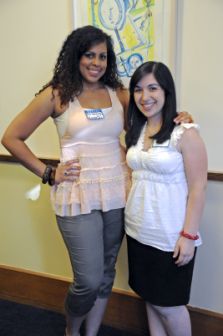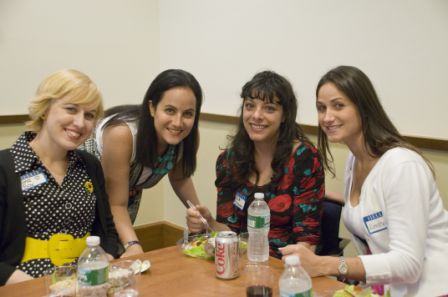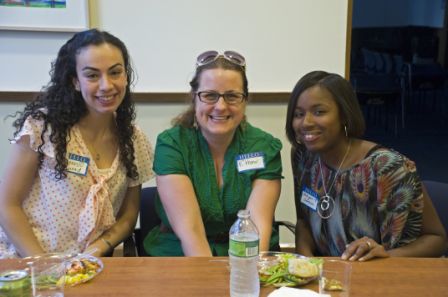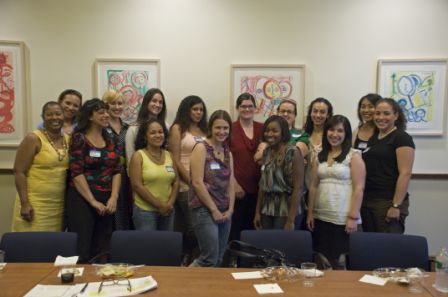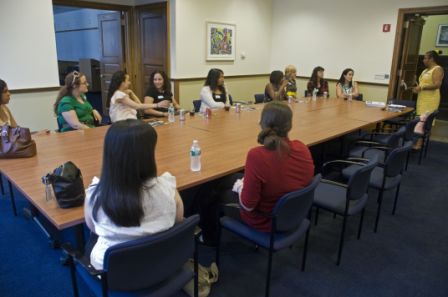For They Were Jolly Good Fellows
“Standing my ground.”
“Parent involvement.”
“Getting into my own skin as a teacher.”
These were just a handful of the responses the question, “What are or were some of your challenges as a first year teacher?” The occasion for asking was the June 18 Petrie Fellow Dinner, which marked the close of a joint partnership between the Carroll and Milton Petrie Foundation and Teachers College, established in 2004, to channel top TC students into urban teaching. Originally conceived as the teaching profession’s version of a Rhodes Scholarship, the Petrie Fellowships granted a total of 100 New York City teachers fellowships to Teachers College, with 50 students receiving $50,000 in funding and the other 50, known as Petrie finalists, receiving partial scholarships, in exchange for a commitment to work in New York City schools.
“Thank you for saying yes to teaching,” Claudette Reid, who has served as coordinator of the Petrie Fellowship Program, said in her welcoming remarks at the dinner, which was the first time that members of all five cohorts of fellows had been in the same room, to share successes and challenges with one another.
Reid thanked those instrumental in making the program a reality, including TC President Susan Fuhrman, past President Arthur Levine, Petrie Foundation Director Nancy Laing, TC Trustee James Comer and Caroline Kennedy Schlossberg.
The program was established in response to the growing difficulty that high-needs New York City public schools faced in recent years in hiring and retaining well-trained, quality teachers. The profession as a whole has been afflicted by a high attrition rate, particularly among teachers who have been working fewer than five years. Thus participants in the Petrie Fellows program were required to teach in New York City public schools for a minimum of five years after graduating from the College.
One Fellow, Nina Box, a member of the first-year cohort, recalled calling Reid upon her acceptance to the program and saying, “But, in five years, I will be thirty—how am I supposed to know if this is right for me?” As it turns out, today Box is still teaching at the same Title I school she started at in 2005.
In fact, Box credits the Petrie Fellowship with putting money and ideals behind her lifelong desire to be a teacher. “I wouldn’t be here if it weren’t for that,” she said.
During the course of the dinner, each of the Fellows present spoke about their experiences in the program, as well as in the classroom. For most of the fifth-year cohort members, who graduated from TC this past spring, the job search for a permanent placement has been challenging. But, as Janelle Gendrano, a fourth-year cohort member noted, “Talking about this fellowship in interviews is an asset. It proves that my commitment to teaching is there.”
The experiences of the Petrie Fellows varied widely. They worked in settings that ranged from kindergarten to high school classrooms, under school leadership that ran the gamut from nurturing to virtually absent. The young people they taught ran the gamut from high-needs ESL students to sixth graders who began the fall reading at a third grade level., Yet all the Fellows seem to share an obvious dedication to an inherently challenging profession.
For Alexandra Mancebo, a member of the fifth-year cohort, the challenges posed by her school’s administration during her first year of teaching were a major part of her learning experience. In learning about her rights, she became close with the school’s representative to the teacher’s union representative, and is now considering succeeding him in that role when he steps down two years from now.
For Monique Johnson Gambino, a member of the second-year cohort who teaches English Language Learning to sixth and seventh graders, student dynamics have been posed the greatest challenges and delivered the biggest rewards “The kids are just how they are supposed to be,” she said, “bad, great, horrible, good—all in one.” Gambino told the story of inviting all of her students to her wedding, even a group of girls that she’d previously had to discipline strongly. In the end, the biggest troublemakers were the ones who showed up to see her get married.
“Kids need to understand the consequences of their behavior,” Gambino said. “And when it comes to discipline, you have to stick to your word.”
“K” Keener, a member of the first-year cohort, recalled the difficulties of her first year of teaching English at a school with a 90 percent teacher attrition rate. “It was the most horrific year,” said Keener, who has since left the school to become a founding English teacher at the Bronx Community High School. Of her current post, she said, “There’s not a single day when I wake up and don’t want to go there.”
Keener added: “I still cry, but now it’s because I’ve gotten a glimpse into my students lives, not because the teaching itself is a challenge.”
Talia Javid, another member of the first cohort, said that when she accepted her first job, she wasn’t sure the school was the right fit. A science teacher, Javid said her earliest experiences were “trial by fire,” in part due to unstable administration (which was in the process of turning over as she started). But five years later, she’s still at the same school and feels completely supported by the administration. The school now has a million-dollar lab, and Javid is teaching Regents physics, as well as a forensic science class she developed.
Published Tuesday, Jul. 13, 2010
